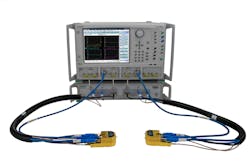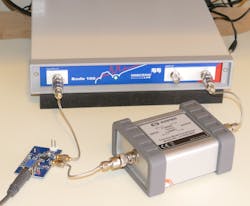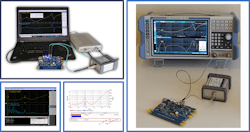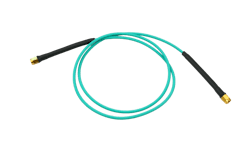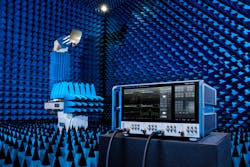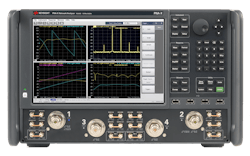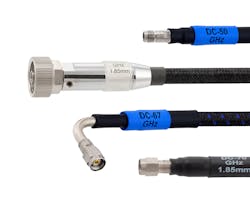This article appeared in Evaluation Engineering and has been published here with permission.
Download this article in PDF format.
In the world of test, measurement, and evaluation, vector network analysis (VNA) is among the most important RF and microwave measurement methodologies. Offering a variety of features, from excellent RF characteristics to a wide variety of analysis functions, the latest VNA solutions facilitate the capture and evaluation of important performance parameters. Here is an overview of some of the latest solutions, by the people from the companies involved.
Advanced Architectures
The ShockLine ME7868A 2-port VNA from Anritsu is designed with an advanced architecture that enables phase-synchronized VNA ports to be physically distributed outside a single chassis. This allows the instrumentation to be located at the device under test (DUT) rather than tied to a single location (Fig. 1).
According to Stan Oda, ShockLine VNA Product Manager, the ME7868A uses the company’s PhaseLync technology to synchronize two ShockLine MS46131A 1-port VNAs. This enables vector insertion loss measurements between the two VNAs. PhaseLync supports synchronization at 100+ meters between 1-port VNAs, improving 2-port S-parameter measurement performance over distances comparable to traditional VNA solutions.
Steve Reyes, Sr. Product Manager, pointed out the VectorStar ME7838G broadband VNA system provides on-wafer device characterization from 70 kHz to 220 GHz in a single sweep. The system uses Anritsu’s Nonlinear Transmission Line (NLTL) modules, which offer excellent performance with industry-best raw directivity, to provide best-in-class calibration performance and measurement stability (Fig. 2).
It enables users to go beyond the traditional boundaries in a single sweep without the need to reconstruct the wafer probe station from a 110 GHz to higher waveguide bands. Anritsu has also recently introduced the Universal Fixture Extraction option (UFX) for VectorStar that fulfills the need for high frequency fixture extractions in signal integrity measurements.
Navneet Kataria, VectorStar VNA Product Manager, added that the VectorStar-based ME7848A Opto-electronic VNA system can characterize opto-electronic devices. These Optical Network Analyzer (ONA) systems combine a VectorStar VNA, E/O convertor, and a silver-standard NIST traceable reference photodetector to make E/O measurements with NIST traceability up to 70 GHz, on devices such as photodetectors and optical modulators/transmitters.
Device Characterization
Over-the-air (OTA) characterization requirements over longer distances for 5G and large vehicle testing are becoming more of a challenge for traditional VNAs, due to long interconnect cables. The ShockLine ME7868A addresses this requirement by moving the VNA port to the DUT, eliminating the cables and improving measurement stability and dynamic range.
On-wafer measurements need to span into the upper mmWave frequencies for accurate device characterization. When developing these systems, it is important to characterize the devices over a much broader frequency range, from near-DC to well beyond the operating frequency. For example, amplifiers designed for applications such as 802.11ad should be swept well beyond 60 GHz into the mmWave regions—ideally beyond 180 GHz—to include 3rd-harmonic testing.
To satisfy next-generation device bandwidth requirements, technologies are being developed that require the use of extremely high frequencies. One such technology is opto-electronics, which offer enormous bandwidth, low latency, and is commercially viable. The demand for testing these opto-electronic devices precisely is a big challenge today. Anritsu’s ONA solution provides accurate and precise measurements with NIST traceability of these opto-electronic devices.
VNAs continue to be used in many varied applications from device characterization to material measurement. The need to perform accurate mmWave measurements well beyond 110 GHz is a key trend. The next-generation 6G cellular network is anticipated to go beyond the 170 GHz D band radio frequencies and enter the 325 GHz regions, to continue to expand data handling capabilities.
Active and Passive Device Characterization
When it comes to addressing specific application spaces, Stan Oda told us that ShockLine VNAs are well-suited for manufacturing and passive component testing. With 1-, 2-, and 4-port VNAs in a variety of packages covering frequencies from 50 kHz to 92 GHz, the ShockLine family of VNAs covers a wide array of applications. Navneet Kataria added that VectorStar VNA covers all the major target markets, namely active and passive device characterization.
Opto-electronic device characterization is another target area for Anritsu’s VectorStar-based ONA systems. Upgradability, flexibility and NIST traceability in measurement results are some of the unique offerings that help our customers. Material measurements capabilities for various material types covering frequencies up to 1.1 THz is another application for VectorStar.
ShockLine VNAs use Anritsu’s patented NLTL technology to achieve cost and space-efficient high-frequency VNA capability. In the future, we expect to continue using this proven technology to increase test capabilities in the ShockLine family. VectorStar also uses NLTL sampler technology for accurate, high-frequency VNA analysis up to 70 GHz baseband and 110, 125, 145, and 220 GHz broadband. The next step in the line of broadband analysis is the ability to perform differential measurements up to 220 GHz for optimum differential analysis.
Anritsu’s position is that VNAs will continue to play a key role in 5G, automotive, and general OTA characterization of all devices, from small UE to large vehicles. As frequencies continue to rise and consolidate on-wafer, the need to perform accurate calibrations in-situ as well as the ability to accurately de-embed test fixtures and on-wafer transmission paths will continue to increase.
Non-Invasive Stability Measurement
When we contacted Charles Hymowitz, the VP of Sales & Marketing at Picotest, he brought up their Non-Invasive Stability Measurement, based on a proprietary piece of software using a math algorithm created by Steve Sandler. However, the company has ported it to many VNAs, at no charge, and are trying to have it added to as many as possible. NISM enables the user to get the phase margin from an output impedance measurement.
Many power supply ICs are fixed, and don’t have their control loops available for Bode plots, and many regulators have multiple internal loops. In some cases, regulators have become so small that breaking the loop has become impractical. Apart from step load testing, which really doesn’t provide a phase margin number, there aren’t other ways to get the control-loop stability of such a regulator except by using NISM.
For example, NISM is included with the OMICRON Lab Bode 100 (Fig. 3), as a software add-on for the Keysight E5061B/E5071C, as well as the Rohde ZNL/ZNLE, and the line of Copper Mountain CMT VNAs. Other ports are in the works.
All of Picotest’s probes and signal injectors can be used with any VNA, allowing DUTs to be connected to the VNA for various measurements (Fig. 4). Most of these injectors (besides the Bode plot related items) are proprietary, and not available from other VNA manufacturers. The various Line injectors, such as the J2102B, offer PDN Cable and support PSRR and 2-port impedance measurement. The J2161A active splitter is unique and can turn an oscilloscope into a VNA.
Many new oscilloscopes can be used as VNAs. Picotest’s J2161A 2-way Wideband Active Splitter, along with their J2102B Common Mode Transformer, can be used to turn many newer scopes into VNAs with the same or greater bandwidth and sensitivity as dedicated VNAs.
Challenges
Two-port impedance measurement is currently the gold standard for low-impedance measurement, with power integrity and PDN (power distribution network) impedance a huge design and performance concern. Apart from simulation, measurement is essential to understanding, bounding, and designing good PDNs.
In order to measure low and ultra-low impedances, Picotest has created a number of accessories essential to accurate measurement including the J2102B/J2113A ground loop breakers (essential for removing the inherent group loop error in the measurement) and low-shield-loss, ultra-thin, flexible PDN cable (Fig. 5).
It is critical when measuring milliohm and microhm PDN impedance that the sources of measurement error be tamed, and these products do that. In addition, Picotest will be introducing a replacement to its current 2-port probe that will be a true 4-port handheld BROWSER probe capable of measuring milli-ohm power plane impedance. Connection to the DUT, especially on dense PCBs is a challenging aspect of PDN impedance measurement and the new Picotest P2102A 2-port probe is going to greatly ease this barrier.
Trends
The trend for oscilloscopes to incorporate VNA capabilities is significant, and one that may dramatically impact sales of traditional VNA instruments, especially as scope vendors incorporate more and better interfaces. One of the most important areas currently for VNAs is power integrity/PDN impedance measurements.
Specifically, two-port measurement of power rail impedance is becoming critically important for almost all systems. This includes power supplies for high-speed digital, or RF circuitry. Traditionally, power rail probes were used to measure time domain noise, but this is unacceptable, as it does not bound the possible voltage excursions that can occur on the rail.
Impedance can define the state of the power rail and possible performance issues. In addition, the frequency band of interest is from low frequency (10s of Hz) out to many GHz, making the measurement both challenging and the domain of the VNA. The company also plans to introduce a series of 1- and 2-port probes that will help VNA users connect to their DUTs.
Powerful and Flexible Tools
The explosion of cloud-enabled systems and the RF-based infrastructures has put a tremendous pressure on engineers serving the wireless space. We reached out to Rich Pieciak, product manager for vector network analyzers at Rohde & Schwarz USA, and asked what the company is fielding to address these issues. He told us the most recent vector network analyzer platforms from Rohde & Schwarz are the R&S ZNA family, and the R&S ZNBT40 platform, which expanded its multiport solutions to 40 GHz, with up to 24 ports (Fig. 6).
The R&S ZNA family of high-performance vector network analyzers address evolving application areas with their sophisticated and flexible hardware architecture. The R&S ZNA family’s RF characteristics are highlighted by sensitivity, power sweep range, and linearity, augmented by a novel hardware architecture with four internal phase-coherent sources, two internal local oscillators, and eight receivers for a high level of measurement versatility.
High-speed digital applications have also been expanded in these two instrument families, (likewise the R&S ZNB and R&S ZND families), with the introduction of new de-embedding solutions giving customers the ability to more easily evaluate and utilize industry-accepted solutions to characterize high-speed digital design structures that support ever-increasing frequency ranges.
Keeping Ahead of the Application
Technology advances in wireless and aerospace & defense applications continue to address integrated assemblies that contain high port counts, due to advanced functions such as beamforming, integrated antenna architectures, and ever-higher digital data transmission rates. All these integration efforts are forcing new approaches to performance validations.
Test instrument architecture needs to evolve to provide the necessary device under test performance insight. The R&S ZNA architecture, for example, can now measure near-field characteristics of an antenna assembly with an integrated LO due to its multiple internal synthesizers and dual local oscillators, coupled with its dual digital receiver architecture.
6G and other research into applications in the mmWave space are putting increased emphasis on extending traditional VNA measurements into frequency areas up to 300 GHz and beyond. Versatile VNA architecture is paramount for proper characterization of the component or corresponding channel environment.
Addressing Applications
High-speed digital designs continue taking on importance and especially in the areas of signal integrity. The proliferation of differing standards and corresponding board layouts are necessitating new ways of probing and analyzing signals in both frequency and time domains. Rohde & Schwarz recently introduced tools to better evaluate the performance of designs and isolate their performance from external sources such as connectors, cables, probes, etc.
New options addressing de-embedding techniques based on the P370 Standard, Smart Fixture De-embedding from Packet Micro, as well as In Situ De-Embedding from AtaiTec are now supported as options in the R&S ZNA, R&S ZNB, R&S ZNBT, and R&S ZND families to allow customers to evaluate the most appropriate techniques to use for their individual applications.
An option addressing Delta-L PCB characterization is now also available. Frequency converting measurements are another core measurement area extremely well-suited to the R&S ZNA, due to its multiple synthesizer architecture and measurement techniques such as those targeted for subassemblies with embedded local oscillators.
The DDS synthesizers in the R&S ZNA are the basis for four phase coherent and phase repeatable sources. The user can define amplitude and phase difference between four signals for applications like beamforming or target simulation. mmWave applications and continued advances in integrated assemblies necessitate continued advancement in test strategy. Test platforms need to evolve accordingly in both architecture and corresponding measurement science.
A Changing Landscape
Network analyzers characterize electronic components in almost every industry. While their versatility has grown, the core architecture of network analyzers has remained largely unchanged for the last few decades. Modern technologies with higher frequencies and wider bandwidths, like 5G, push the limits of current network analyzers and create new challenges for engineers as they measure multichannel devices.
Matt Campbell, Product Marketing Engineer at Keysight Technologies, pointed out that network analyzer sources traditionally didn’t have to be highly accurate, as discontinuities could just be ratioed out of the measurements. However, source performance can have a more significant impact on today’s complex wideband and nonlinear measurements.
Addressing this, Keysight enabled their PNA and PNA-X network analyzers with the same signal source as their high-end signal generators. Presented as having the lowest phase noise available, engineers can quickly perform measurements like EVM, converter measurements with phase, and nonlinear network analysis with confidence in the results (Fig. 7).
To help with 5G manufacturing test, Keysight introduced their vector component analyzer, presented as the first modular multiport instrument that can perform both network analysis and modulated signal measurements. This enables designers to perform network analyzer measurements like S-parameters and gain simultaneously with EVM and ACP.
Matt pointed out that when customers look for network analyzers, applications like pulsed-RF measurements, spectrum analysis, and time domain analysis are often as important to them as S-parameters. People are thinking of network analyzers as general RF tools, not just S-parameter machines, and Keysight’s network analyzers offer features such as guided calibration with an ECal module and wizards that walk through advanced measurements.
Keysight’s network analyzers cover every application, from R&D to manufacturing, to field test with form factors tailored to each respective application. Convenient and capable USB VNAs, multiport VNAs with up to 50 ports, and the rugged handheld FieldFox, bring performance wherever it's needed. Nearly every industry is seeing frequencies go up and devices become more integrated, so Keysight provides frequency coverage into millimeter frequencies as well as flexible measurement applications for every form factor.
Connections Are Important
A link of any kind is only as good as its connectors and cable, and test is no exception. According to Steve Ellis, Product Line Manager at Pasternack, their latest line of highly-flexible VNA test cables addresses a wide range of demanding lab and test applications (Fig. 8). Features include a phase stability of ±6° at 50 GHz, and ±8° at 70 GHz with flexure, as well as VSWR of 1.3:1 at 50 GHz and 1.4:1 at 70 GHz.
These 50 GHz assemblies are terminated with 2.4-mm connectors, while the 70 GHz assemblies utilize 1.85-mm connectors. The braided, stainless-steel armoring surrounding the coax provides a rugged yet flexible cable with a flex life exceeding 100,000 cycles, and the cables are terminated with rugged, stainless-steel connectors that provide up to 5,000 mating cycles when attached with proper care. Both 50 and 70 GHz versions are offered with NMD-style connectors, with swept right-angle 2.4- and 1.85-mm connector options.
About the Author
Alix Paultre
Editor-at-Large, Microwaves & RF
Alix is Editor-at-Large for Microwaves & RF.
An Army veteran, Alix Paultre was a signals intelligence soldier on the East/West German border in the early ‘80s, and eventually wound up helping launch and run a publication on consumer electronics for the U.S. military stationed in Europe. Alix first began in this industry in 1998 at Electronic Products magazine, and since then has worked for a variety of publications, most recently as Editor-in-Chief of Power Systems Design.
Alix currently lives in Wiesbaden, Germany.


